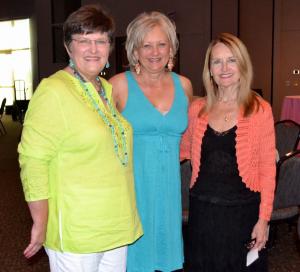2015 ECEP News
Dr. Honeycutt Attends Children's House Fundraiser
ECEP Assistant Director Deniece Honeycutt attended the 12th annual fundraiser Summer Salsa for EOA Children's House on June 20 in Fayetteville.
With the assistance of caring donors and volunteers, EOA Children's House helps abused children heal through extended care and family support in a safe, homelike setting.
Since it's founding in 1978, thousands of children have received care at EOA Children's House and have gone on to be productive adults. EOA's Children's House has provided all the care needed for the youngest victims of abuse in a single location, lessening the stress of their lives. Now, with the new Pat Walker Children's House facility, Children's House continues to help abused children get back on track to healthy, productive lives.

Left: Donna Alliston, Deniece Honeycutt and Woodie Sue Herlein
Photo courtesy of The City Wire
Outcomes Survey in the Arkansas Better Chance Program
ECEP is conducting research about the relationship of teacher qualifications, quality of care and student achievement outcomes in the Arkansas Better Chance (ABC) program. Deniece Honeycutt conducted research on this topic in 2008.
2008 research listed below.
Abstract: The purpose of this study was to conduct a program evaluation of the Arkansas Better Chance Program and determine if a relationship existed among teacher qualifications, quality of care and student achievement outcomes. The teacher qualifications were measured with a researcher designed questionnaire. The variables for teacher qualifications were wage, experience, education and training (Framework, Pre-K ELLA, WSS). The quality of care was measured with the Early Childhood Environment Rating Scale Revised (ECERS-R). The student achievement outcomes were measured with the Work Sampling System (WSS- these scores were turned into percent proficient scores).
The ABC teacher workforce is predominately young white females with a teaching degree and license. She earns less than $25,000 per year. The ABC student is a white English-speaking boy or girl at 200 percent of poverty level.
A significant difference was found in student achievement based on teacher qualifications (wage, experience and Pre-K ELLA training). A significant difference was found in quality of care based on teacher qualifications (experience, Framework and Pre-K ELLA training).
A relationship was found between student achievement and quality of care; specifically, student achievement, the total ECERS-R scores and each of the subscale scores (language-reasoning, space and furnishings, activities, interaction, program structure). A relationship was found among teacher qualifications, quality of care and student achievement: specifically, between Framework and Pre-K ELLA; Pre-K ELLA and WSS; Framework and WSS; WSS and education; WSS and wage; wage and education; Pre-K ELLA and experience; Framework and experience; ECERS-R and experience; and, percent proficient and ECERS-R.
Previous research findings
Figure 2 - Context of ABC Programs
ECEP Offers 2-Day Poverty Institute with Dr. Donna Beegle on March 9—10
